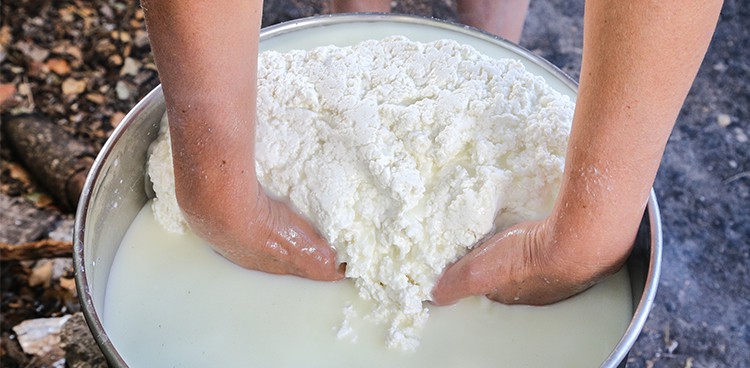
It makes sense that cheesemaking (and a lot of other things, let’s be real) is a lot trickier in hot climates like the Mediterranean and the Middle East. In these environs, overly rapid acceleration of mold growth, spoilage, and surface cracking are highly problematic to the production of edible cheese. Added to that mix of course, is the lack of refrigeration in ancient times. So what were cheese-pioneering inhabitants of these warmer regions to do?
Well, the answer to this pickle is, in fact, pickling AKA brining. Brining cheeses originated as a way to inhibit bacterial growth so that the cheese was safe to consume. The cheese is soaked and then stored in an acidified saltwater solution. It’s not so different from what you do to your cucumbers.
There is a whole host of brined cheeses, ranging from the readily recognizable (feta) to the more obscure (Egyptian domiati), and they come in textures ranging from crumbly to creamy.
Let’s start with the poster child of brined cheese, feta. Think back to those high school and college courses on Greek classics. (Stay with me!) Even that famously epic poem The Odyssey talks about feta. (Although not mentioned by name in the poem, it is thought that the Polyphemus, the Cyclops, with his “pails and bowls for milking… swimming in whey” was making none other than feta—check out our blog post on the subject!) In Greece, Feta (with a capital F, because here Greek law strictly requires the cheese to contain at minimum 70% sheep’s milk) is eaten at almost every meal. A fine example of Feta is Mount Vikos Barrel Aged Feta, made in Thessaly, Greece. It’s aged for at least four months, and is characterized by clean, lactic, milky notes and a slight lemony tang.
American, French, and Bulgarian feta, however, aren’t held to the 70% sheep’s milk requirement. For example, Vermont’s Maplebrook Farm feta is made from whole cow’s milk, which accounts for it is uncharacteristically silky texture, and is finished with sea salt for a punchy finish.
Feta can stand alone as an appetizer with a bit of oregano and olive oil, and it also marries well in salads with tomatoes, cucumbers, and other briny cohorts like olives. Whipped feta is a crave-worthy dip that can be flavored with the likes of peppers, chilis, and garlic. For a better bird brine, Melissa Clark of The New York Times recommends blending feta with water and soaking your chicken in that delightful mixture before roasting.
Moseying on over to the Cyprus, you couldn’t find a more texturally disparate example of brined cheese than the bouncy-textured, miraculously unmeltable halloumi. (It’s the cheese that CAN take the heat in the kitchen). Halloumi is most often grilled, broiled or fried, and its appealing saltiness is best complemented by the sweetness of figs and honey.
In Italy, you’ll find ricotta salata—an aged ricotta that is salted (hence “salata”), aged, and pressed to firmness. It is perfect cubed or shaved over salad or pasta.
And lest you think that brined cheeses are confined to the Mediterranean and the Middle East, another shining star of brined cheeses is one of Mexico’s oldest: cotija. Named for the town in Michoacán, this salty, tangy cow’s milk cheese can range from moist to dry and very crumbly. It finds its way into many staple dishes, including beans, tacos, chile rellenos, and chilaquiles.
Modern food storage techniques may have lessened the absolute necessity of brining cheeses to preserve them, but one things for sure: The cheese-eaters of the 21st century will always have a place in their hearts (and their stomachs) for brined cheese.




